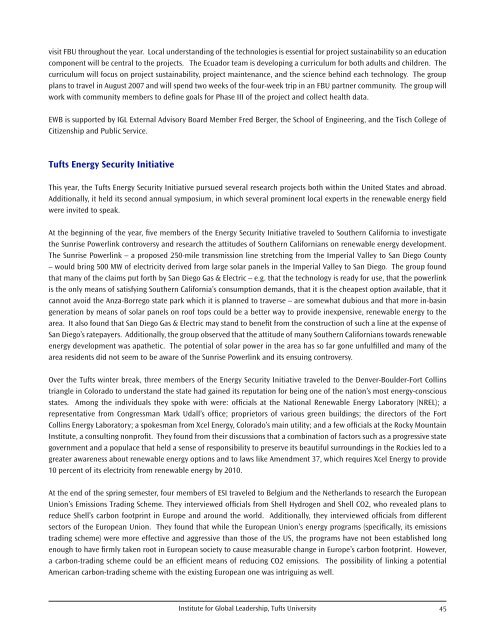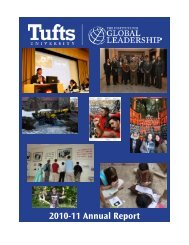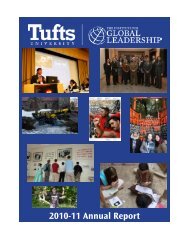Download - Institute for Global Leadership
Download - Institute for Global Leadership
Download - Institute for Global Leadership
You also want an ePaper? Increase the reach of your titles
YUMPU automatically turns print PDFs into web optimized ePapers that Google loves.
visit FBU throughout the year. Local understanding of the technologies is essential <strong>for</strong> project sustainability so an education<br />
component will be central to the projects. The Ecuador team is developing a curriculum <strong>for</strong> both adults and children. The<br />
curriculum will focus on project sustainability, project maintenance, and the science behind each technology. The group<br />
plans to travel in August 2007 and will spend two weeks of the four-week trip in an FBU partner community. The group will<br />
work with community members to define goals <strong>for</strong> Phase III of the project and collect health data.<br />
EWB is supported by IGL External Advisory Board Member Fred Berger, the School of Engineering, and the Tisch College of<br />
Citizenship and Public Service.<br />
Tufts Energy Security Initiative<br />
This year, the Tufts Energy Security Initiative pursued several research projects both within the United States and abroad.<br />
Additionally, it held its second annual symposium, in which several prominent local experts in the renewable energy field<br />
were invited to speak.<br />
At the beginning of the year, five members of the Energy Security Initiative traveled to Southern Cali<strong>for</strong>nia to investigate<br />
the Sunrise Powerlink controversy and research the attitudes of Southern Cali<strong>for</strong>nians on renewable energy development.<br />
The Sunrise Powerlink – a proposed 250-mile transmission line stretching from the Imperial Valley to San Diego County<br />
– would bring 500 MW of electricity derived from large solar panels in the Imperial Valley to San Diego. The group found<br />
that many of the claims put <strong>for</strong>th by San Diego Gas & Electric – e.g. that the technology is ready <strong>for</strong> use, that the powerlink<br />
is the only means of satisfying Southern Cali<strong>for</strong>nia’s consumption demands, that it is the cheapest option available, that it<br />
cannot avoid the Anza-Borrego state park which it is planned to traverse – are somewhat dubious and that more in-basin<br />
generation by means of solar panels on roof tops could be a better way to provide inexpensive, renewable energy to the<br />
area. It also found that San Diego Gas & Electric may stand to benefit from the construction of such a line at the expense of<br />
San Diego’s ratepayers. Additionally, the group observed that the attitude of many Southern Cali<strong>for</strong>nians towards renewable<br />
energy development was apathetic. The potential of solar power in the area has so far gone unfulfilled and many of the<br />
area residents did not seem to be aware of the Sunrise Powerlink and its ensuing controversy.<br />
Over the Tufts winter break, three members of the Energy Security Initiative traveled to the Denver-Boulder-Fort Collins<br />
triangle in Colorado to understand the state had gained its reputation <strong>for</strong> being one of the nation’s most energy-conscious<br />
states. Among the individuals they spoke with were: officials at the National Renewable Energy Laboratory (NREL); a<br />
representative from Congressman Mark Udall’s office; proprietors of various green buildings; the directors of the Fort<br />
Collins Energy Laboratory; a spokesman from Xcel Energy, Colorado’s main utility; and a few officials at the Rocky Mountain<br />
<strong>Institute</strong>, a consulting nonprofit. They found from their discussions that a combination of factors such as a progressive state<br />
government and a populace that held a sense of responsibility to preserve its beautiful surroundings in the Rockies led to a<br />
greater awareness about renewable energy options and to laws like Amendment 37, which requires Xcel Energy to provide<br />
10 percent of its electricity from renewable energy by 2010.<br />
At the end of the spring semester, four members of ESI traveled to Belgium and the Netherlands to research the European<br />
Union’s Emissions Trading Scheme. They interviewed officials from Shell Hydrogen and Shell CO2, who revealed plans to<br />
reduce Shell’s carbon footprint in Europe and around the world. Additionally, they interviewed officials from different<br />
sectors of the European Union. They found that while the European Union’s energy programs (specifically, its emissions<br />
trading scheme) were more effective and aggressive than those of the US, the programs have not been established long<br />
enough to have firmly taken root in European society to cause measurable change in Europe’s carbon footprint. However,<br />
a carbon-trading scheme could be an efficient means of reducing CO2 emissions. The possibility of linking a potential<br />
American carbon-trading scheme with the existing European one was intriguing as well.<br />
<strong>Institute</strong> <strong>for</strong> <strong>Global</strong> <strong>Leadership</strong>, Tufts University 45






